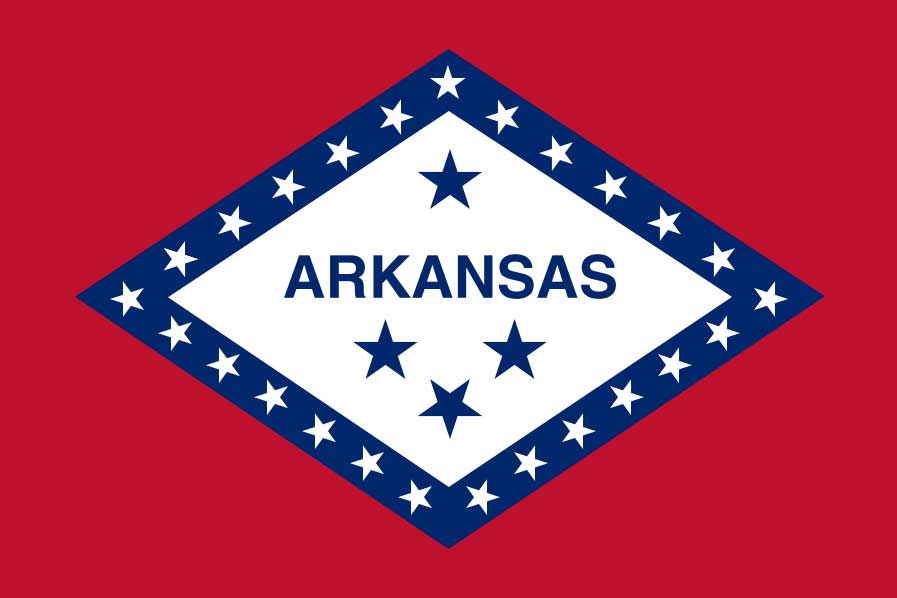Arkansas


Basic Information
Postal Abbreviation: AR
Natives: Arkansan
Population. 2020: 3,011,524
Legal Driving Age: 16
Age of Majority: 18
Median Age: 37.4
STATE SONG: “Arkansas”
Lyrics: Eva Ware Barnett
Music: Eva Ware Barnett
Median Household Income:$43,813
Capital..... Little Rock
Entered Union..... June 15,1836 (25th)
Present constitution adopted: 1874
Nickname: Land of Opportunity
Motto:
“Regnat Populus” (The people rule)
Origin of name:
From the Quapaw Indian. Called "Kansas" in Algonkian. Arkansas resembles the French pronunciation of this tribal name- a tribe encountered
French explorers on their way down the Mississippi.
USS Arkansas
Railroad Stations
Arkansas Economy
AGRICULTURE: cattle, chickens,
cottons, eggs, rice, soybeans, wood.
MINING: bromine, natural gas,
petroleum, stone.
MANUFACTURING: chemicals, clothing,
electronics, food processing, furniture,
lumber, machinery, metals, paper,
plastic, shoes.

Arkansas Geography
Total Area: 53,182 sq. miles
Land area: 52,075 sq. miles
Water Area: 1,107 sq. miles
Geographic Center: Pulaski County
12 mi. NW of Little Rock
Highest Point: Magazine Mountain
Logan City (2,753 ft.)
Lowest Point: Ouachita River
Ashley/Union Counties (55 ft.)
Highest Recorded Temp.: 120˚ F (8/10/1936)
Lowest Recorded Temp.: -29˚ F (2/13/1905)
Arkansas has the Ozark Mountains in the north and the Quachitia Mountains in the west. This is known as the highlands. The "highlands" contain small towns and farms. The south and east with their plains and prairies are known as the "lowlands". Most of the population of Arkansas lives in the "lowland" region. The Arkansas River crosses the state from northwest to southeast.
Cities
Little Rock, 197,881;
Fort Smith, 87,845;
Fayetteville,86,751;
Springdale, 81,029;
Jonesboro, 76,990;
North Little Rock, 66,127;
Conway, 66,426;
Rogers, 67,600;
Pine Bluff, 42,271;
Bentonville, 35,301
Arkansas History
1541 Spanish explorer Hernando de Soto established winter camp in Arkansas .
1682 La Salle reached Arkansas on his voyage down the Mississippi and
claimed it for France.
1686 The first permanent white settlement was established at Arkansas post.
1721 That post was abandoned.
1803 Arkansas becomes part of the United States with the US executes the
Louisiana purchase.
1819 Arkansas which had been part of Louisiana territory becomes a separate
territory.
1821 The capital of Arkansas was moved to Little Rock.
1822 The first steamboat arrived at Little Rock on the Arkansas River.
1836 Arkansas was admitted to the Union as the 25th state.
1861 Arkansas seceded from the Union.
1862 The Battle of Pea Ridge was fought in Northwest Arkansas.
1863 Federal troops occupied Little Rock.
1868 Arkansas was readmitted to the Union.
1891 Jim Crow legislation segregates railroad coaches and other public
accommodations.
1921 Oil is found near El Dorado.
1928 A law was passed outlawing the teaching of evolution in the classroom.
1957 Under orders from Governor Oval Faubus the Arkansas National Guard
turns away nine black students when they attempt to desegregate the Little
Rock High School. President Eisenhower calls in Federal troops to
desegregate the school.
1968 - The Assassination of Dr. Martin Luther King Jr.
Famous People
Maya Angelou
Glen Cambell
Hattie Caraway
Bill Clinton
Willim Fulbright
Douglas MacArthur
.png)
Arkansas National Sites
1) Arkansas Post National Monument
This was the first European settlement on the lower Mississippi River Valley. In 1821 the territorial capital was moved to Little Rock and soon Arkansas Post was abandoned. Today the 389 acre park contains some of the remains of the town. As well as museum that tells the story of early settlement to Arkansas
2) Fort Smith National Park
Fort Smith was built in 1817 to guard against Indian attacks. During its 80 years of operation it played a key roll in the development of the state.
3) Hot Springs National Park
This park center point are the hot springs that it is named for. Each day 1 million gallons of water at 143 degrees fahrenheit flow from the parks 47 springs. Its is only 5,549 acres in size making it the smallest national park in the nation.
4) Pea Ridge National Military Park
The Park which sets on 4,300 acres preserved the ground of the battle of Pea Ridge. The battle took place on March 7-8 1862.
 >
>